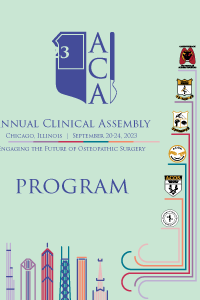ACOS 2023 Annual Clinical Assembly
Urological Surgery
Comparison of pathologic outcomes in transitional zone vs peripheral zone targeted prostate lesions on MRI fusion prostate biopsy
- ZT
Zachariah Taylor, DO
Urology Resident
Main Line HealthDisclosure(s): No financial relationships to disclose
Member Speaker(s)
Learning Objectives:
- Upon completion, participant will be able to better understand the difficulty in obtaining prostate biopsy from transitional zone lesion
- Upon completion, participant will be able to the pathologic outcomes of transitional zone lesions compared to peripheral zone lesions
- Upon completion, participant will be able to counsel patients better regarding MRI findings and possible outcomes following prostate biopsy
MRI is the most accurate diagnostic imaging tool for detecting prostate cancer (PCa) in the peripheral zone (PZ) and transitional zone (TZ). PCa occurs mainly in the PZ; around 30% of malignancy occurs in the TZ. Lesions in the TZ are difficult to biopsy and challenging for radiologists to characterize with various confounding differentials, notably benign prostatic hyperplasia. We wanted to ascertain whether the PI-RADS score underestimated the final biopsy pathology in PZ lesions compared to TZ lesions.
Methods or Case Description:
Retrospective review of MRI fusion biopsies performed at multiple institutions from 2020-2022. PI-RADS 3 (P3), 4 (P4), and 5 (P5) lesions were included. Patient and lesion characteristics as well as eventual treatment were recorded.
Outcomes:
There were a total of 351 PZ lesions and 55 TZ lesions included. The PZ lesions included 97 (27.6%) P3, 201 (57.3%) P4, and 53 (15.1%) P5 lesions, while TZ included 22 (40.0%), 15 (27.3%), and 18 (32.7%) lesions respectively. Of these PZ lesions, 241 (68.7%) were found to be benign compared to 32 (58.2%) of the TZ lesions. Of the 241 benign lesions in the PZ group, other cores were positive for cancer in 41.3% of patients compared to 40.6% of patients in the TZ group. Analysis of P4 lesions demonstrated a higher benign rate in the PZ group than the TZ group (65.7% vs 33.3%, p< 0.05).
Conclusion:
TZ lesions demonstrate the same malignant potential as PZ lesions with no difference in the rate of benign biopsy or finding of more significant cancer in other cores. TZ P4 lesions demonstrated a higher rate of detecting cancer than PZ P4 lesions.

